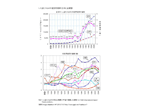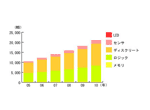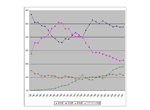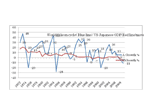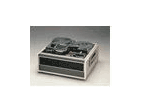Trends in the Semiconductor Industry
1970s
Japanese IC-manufacturing industry continues to make remarkable progress.
Start of the LSI era
Early 1970s: Japan's remarkable postwar economic recovery
Japan's economic growth has been remarkable since postwar reconstruction, reaching per capita GDP of $2,000 (1950), $4,000 (1960), and $10,000 (1970). However, responses from other countries were a complex mix of astonishment and accusatory comments.
First half of 1970s: Japan starts developing ICs for automobiles ahead of the U.S.
Development of ICs for automobiles started with analog ICs for in-car entertainment, and was followed by 4-bit microcontrollers and other digital ICs for use with the wipers, electronic locks, and dashboard, and then by microcontrollers with 8-bit and wider bits for engine control.
1970: Scale of the global semiconductor market is 870 billion yen
The top three semiconductor suppliers were TI, Motorola, and Fairchild. Consumer electronics, the speciality of the Japanese suppliers, still only constituted a small portion of the global market. Market share: US: 48%, Japan: 25%, Europe: 26%, Others: 1%
1971 to mid-1970s: Development of CPUs advances in the U.S. and Japan
With technical aid from Busicom in Japan, Intel developed the first 4-bit MPU 4004 for use in electronic calculators and, in 1974, released the 8080, an 8-bit NMOS MPU. With the 6800 from Motorola and later the Z80 from Zilog also appearing, the basic functionality of MPUs were defined. The development of MCUs by Japanese manufacturers advanced from the mid-1970s, with 4-bit MCUs starting to take a large share of the market in home appliances applications.
1972 and later: Marked increase in sales of ICs for electronic calculators and watches
Japanese semiconductor manufacturers produced a large quantity of CMOS LSIs, with each company producing one to two million LSIs per month in 1974. In particular, low-power CMOS LSIs promoted the development of other consumer electronics products, which then firmly secured the world’s number one position.
Around 1974: Economic depression due to oil crisis leads to the first decline of the market for semiconductors
The global semiconductor market, which had grown 100-fold in 22 years (from one hundred million dollars in 1957 to one billion dollars in 1964, and then to ten billion dollars in 1979), experienced a two-digit percentage decline in 1975. This was the first of the declines in the so-called silicon cycles.
1974: Japan fully liberalizes the import of ICs
In early 1970, Japanese electronics companies imported digital ICs and introduced related technologies from U.S. semiconductor manufacturers, and developed partnerships with the latter. In the mid-1970s, however, a shift by Japanese electronics companies to using more Japanese-made semiconductor products resulted in a drastic decrease in imports from U.S. semiconductor manufacturers. Under the pressure from the U.S. government, the Japanese government fully liberalized the import of ICs in 1974.
1975: Sony releases the Betamax-format VCR
Release of the VHS-format VCR by the Victor Company of Japan (JVC) in 1976 following the Betamax-format by Sony in 1975 initiated the competition to set the standard format between the two Japanese manufacturers. The VCR was one of the most important applications of analog ICs for AV devices.
1975: Establishment of the VLSI Technology Research Association
From a basis in the Electrotechnical Laboratory of the Agency of Industrial Science and Technology and with an investment of 110 billion yen, the VLSI Technology Research Association was launched with Fujitsu, Hitachi, NEC, Mitsubishi, and Toshiba as its members. Its goals were developing state-of-the-art fabrication processes and photoexposure patterning equipment for microfabrication, and creating prototypes of a one-mm process and one-Mbit DRAM within five years.
Mid-1970s and later: Japanese semiconductor manufacturers strongly promote automated production
To achieve the same highest levels of quality for mass-produced ICs as obtained through the technologies for making prototype ICs developed throughout the 1970s, Japanese semiconductor manufacturers strongly promoted automated production scheme. In particular, automated bonding processes in back-end manufacturing operations were strong focus. In contrast to wafer-fabrication processes, which were more dependent on facilities and equiepment, back-end processes depended more on manual works. This set the limit to the uniformity of quality and speed of operations, as the insufficient operator work force, increased complexity of operator tasks became appearant.
1977: Foundation of the Semiconductor Industry Association (SIA) in the U.S.
The SIA submitted a report on Japan’s VLSI project to the U.S. government and, under the flag of the Semiconductor Research Corporation, suggested strengthening ties between the industry and universities to advance the development of ICs in the U.S.
1979: Intel releases the 8088, the 16-bit MPU employed in IBM PCs and IBM-compatible machines in 1982
The 8088 and Microsoft’s MS-DOS initiated IBM’s open-architecture PCs.
With the birth of numerous IBM-compatible machines, this was the beginning of Wintel (Windows and Intel) becoming the de facto standard.
Late 1970s: Significant growth in the Japanese market for semiconductor products in computers, telecommunications, and industrial purposes under way
In these high-end microcontroller markets , Intel, Zilog, and Motorola in the U.S. were the world’s major manufacturers. Japanese manufacturers set off in catching up with both original and replacement products.


